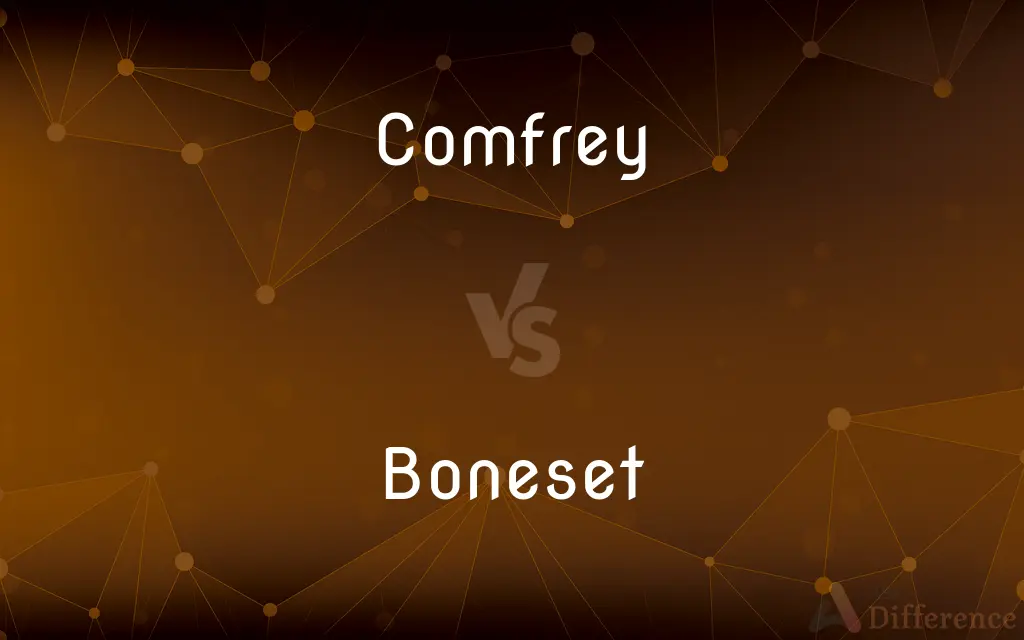Comfrey vs. Boneset — What's the Difference?
By Urooj Arif & Fiza Rafique — Updated on April 2, 2024
Comfrey is a healing herb used topically for wounds, while boneset is known for treating fever and cold symptoms.

Difference Between Comfrey and Boneset
Table of Contents
ADVERTISEMENT
Key Differences
Comfrey, scientifically known as Symphytum officinale, is a perennial herb recognized for its broad, hairy leaves and bell-shaped flowers, typically purple, pink, or white. It has a long history in herbal medicine, primarily used for its ability to speed up the healing of wounds, bruises, sprains, and broken bones when applied externally. In contrast, boneset, Eupatorium perfoliatum, features narrow, lance-shaped leaves and clusters of small, white flowers. It has been traditionally used to treat fevers, influenza, and cold symptoms, administered as a tea made from its leaves and flowers.
The active compounds in comfrey, including allantoin, rosmarinic acid, and mucilage, contribute to its anti-inflammatory and cell proliferative properties, which are beneficial for skin and bone healing. On the other hand, boneset contains several compounds such as flavonoids and sesquiterpene lactones, which are thought to support the immune system and reduce inflammation, making it effective in treating symptoms of colds and flu.
Comfrey is advised to be used topically due to the presence of pyrrolizidine alkaloids, which can be harmful if ingested, leading to liver damage. Therefore, its internal use is generally discouraged. Conversely, boneset was historically used both internally and externally, but its internal use should be approached with caution due to potential side effects, including liver toxicity if used in large quantities or for extended periods.
Both herbs have been valued in traditional medicine for centuries; however, their uses and applications differ significantly. Comfrey is often found in salves and ointments for external application on the skin, while boneset is typically prepared as a tea or tincture for internal use to alleviate fever and respiratory symptoms.
The cultivation and care of these plants also differ. Comfrey thrives in moist, fertile soil and can be propagated from root cuttings, whereas boneset prefers wet habitats, like those near streams or in marshes, and can be grown from seeds or by dividing the plant in spring or fall.
ADVERTISEMENT
Comparison Chart
Scientific Name
Symphytum officinale
Eupatorium perfoliatum
Usage
Used topically for wounds, sprains, and bruises.
Used to treat fevers, colds, and flu symptoms.
Active Compounds
Allantoin, rosmarinic acid, mucilage.
Flavonoids, sesquiterpene lactones.
Administration
Topical application due to toxicity if ingested.
Primarily ingested as tea; caution advised.
Safety Concerns
Contains pyrrolizidine alkaloids; not for ingestion.
Potential liver toxicity if overused.
Habitat
Moist, fertile soil.
Wet areas, near streams, or in marshes.
Compare with Definitions
Comfrey
Grows best in moist, well-drained soil.
Comfrey plants thrived at the edge of the garden, where the soil retained moisture.
Boneset
A herb traditionally used to treat fever and flu.
The herbal tea made from boneset helped alleviate his flu symptoms.
Comfrey
A perennial herb known for its wound-healing properties.
The gardener applied a comfrey salve to the cuts while pruning roses.
Boneset
Known for its immune-boosting flavonoids.
Boneset tea is considered a natural remedy for boosting the immune system.
Comfrey
Advised for external use due to liver toxicity risks.
Despite comfrey's healing properties, consuming it is strongly discouraged.
Boneset
Prefers growing in wet, marshy areas.
They found wild boneset thriving beside the stream.
Comfrey
Contains allantoin, promoting skin cell regeneration.
Comfrey ointments are popular among herbalists for skin care.
Boneset
Often prepared as a tea or tincture for internal use.
She prepared a tincture from boneset to keep on hand during cold season.
Comfrey
Used in herbal medicine and permaculture.
In permaculture, comfrey is used as a green manure for soil improvement.
Boneset
Used with caution due to potential liver toxicity.
Overuse of boneset in herbal concoctions can lead to health issues.
Comfrey
Any of various hairy perennial Eurasian herbs of the genus Symphytum, especially S. officinale, having variously colored flowers in coiled cymes and long used in herbal medicine.
Boneset
The herb common boneset (Eupatorium perfoliatum).
Comfrey
Any of several species of perennial herbs of the genus Symphytum, often specifically Symphytum officinale.
Boneset
A medicinal plant, the thoroughwort (Eupatorium perfoliatum). Its properties are diaphoretic and tonic.
Comfrey
A rough, hairy, perennial plant of several species, of the genus Symphytum.
Boneset
European herb having small white, pink or purple flowers; naturalized as a weed in North America
Comfrey
Perennial herbs of Europe and Iran; make rapidly growing groundcover for shaded areas
Boneset
Boneset may refer to:
Comfrey
Leaves make a popular tisane; young leaves used in salads or cooked
Boneset
Any of several plants of the genus Eupatorium in the composite family, especially the eastern North American species E. perfoliatum, having opposite leaves united around the stem and clusters of small white flower heads. Also called thoroughwort.
Boneset
Any of several plants of the genera Eupatorium and Ageratina.
Boneset
Comfrey.
Boneset
Perennial herb of southeastern United States having white-rayed flower heads; formerly used as in folk medicine
Common Curiosities
What is comfrey used for?
Comfrey is used topically for healing wounds, bruises, and sprains due to its skin regeneration properties.
Are there safety concerns with using comfrey?
Yes, due to pyrrolizidine alkaloids, comfrey should not be ingested and is recommended for external use only.
Can boneset be used externally?
While less common, boneset has been used externally, but it is primarily known for its internal use to treat fevers and colds.
Is comfrey safe for all topical applications?
While safe for most topical applications, it's advisable to avoid use on open wounds due to absorption of toxic alkaloids.
How is boneset traditionally used?
Boneset is traditionally used to treat fevers, influenza, and cold symptoms, often consumed as a tea.
What makes comfrey effective for skin healing?
Comfrey contains allantoin, which promotes cell proliferation, making it effective for skin healing.
Can both herbs be grown in a home garden?
Yes, both can be grown in a home garden, provided their specific growing conditions are met.
What are the cultivation needs of comfrey?
Comfrey needs moist, well-drained soil and can tolerate partial shade.
Can comfrey and boneset be used for pets?
While some herbal remedies may be safe for pets, it's crucial to consult with a veterinarian due to potential toxicity.
What precautions should be taken when using these herbs?
It's important to adhere to recommended dosages and applications, especially avoiding internal use of comfrey.
How does boneset support the immune system?
Boneset contains compounds like flavonoids that are thought to support the immune system.
Why should boneset be used with caution?
Due to the potential for liver toxicity, boneset should be used cautiously, especially when ingested.
What distinguishes the habitats of comfrey and boneset?
Comfrey prefers moist, fertile soil, while boneset thrives in wetter, marsh-like environments.
Are there any herbal remedies combining comfrey and boneset?
Herbal remedies typically use these herbs separately due to their different applications and safety concerns.
Share Your Discovery

Previous Comparison
Percolate vs. Penetrate
Next Comparison
G vs. GbAuthor Spotlight
Written by
Urooj ArifUrooj is a skilled content writer at Ask Difference, known for her exceptional ability to simplify complex topics into engaging and informative content. With a passion for research and a flair for clear, concise writing, she consistently delivers articles that resonate with our diverse audience.
Co-written by
Fiza RafiqueFiza Rafique is a skilled content writer at AskDifference.com, where she meticulously refines and enhances written pieces. Drawing from her vast editorial expertise, Fiza ensures clarity, accuracy, and precision in every article. Passionate about language, she continually seeks to elevate the quality of content for readers worldwide.















































